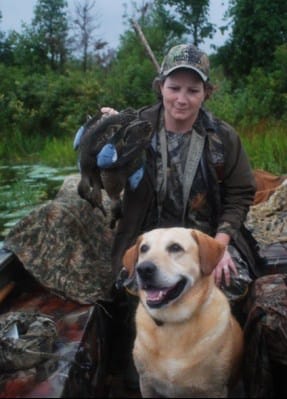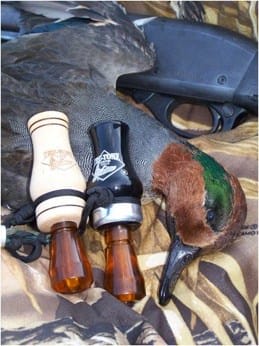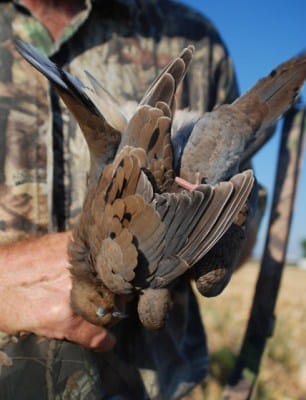
Warm breezes ripple yellowing walnut trees in the fading darkness. The pungent, sweet smell of willow leaves giving up life fill the still air. It’s that magical time of year between summer and fall we call autumn. This short season is special in the hearts of wingshooters. Both teal and dove season arrive when the slightest cooling of northern winds cause a nervousness among the earliest of migrating waterfowl, the Blue-winged teal. I hear the rushing of air pouring over the wings of a hundred birds as they zoom overhead at 60 mph in the fading darkness. I hope to take four of these perplexing targets to combine with the equally difficult to hit dozen doves I hope to collect in the afternoon.
U.S. Fish and Wildlife experts expect 9.2 million Blue-winged teal to come down the flyways in 2012, 3 percent more than in 2011 and 94 percent above the long term average. Toss in another 3.4 million green-winged teal and you have the perfect recipe for a splendid autumn teal season.
Dr. Frank Rohwer, Delta Waterfowl’s scientific director, said, “We have the highest number of total ducks migrating this year since we began the survey in 1955.”
Well over 45 million ducks are expected in the fall migrations. The autumn teal season may serve as a prelude to better things to come.
Thirty blue-wings zip across the outside corner of my set, having caught me daydreaming of the afternoon dove hunt planned for one of my favorite spots. Dove and teal are equally formidable targets.
“There they are,” I whisper to my wife, Dian. “Low, against the far bank. They will hit the west end of the lake and come into the set from the right. Get ready.”
Muscles tense as we crouch a bit lower in the boat, hoping to hide both our shapes and our intentions. Pete, my yellow Lab, groans and trembles with excitement.
“Steady boy,” I whisper.
Dian fires first as the speed demons hit the right end of the decoy set, 40 yards out. The first blue-wing of autumn tumbles out of the sky. I fire a milli-second behind her and miss. And miss again. Two more teal are tumbling from the sky when I swing on another bird and am relieved when it crumples and crashes.
“Pete!”, I yell, and he is in the water before my lips relax from calling his name. I can feel Dian staring at me.
“What do you say?” she queried.
“Dang good shootin’,” I replied. “Three shots, three birds. Hard to beat, but I think my one bird is bigger than any of yours.”

Minutes later twenty more blue-wings target the middle of the set. Dian’s one shot filled her four duck limit. My trio of rounds added one more to my bag. I didn’t even look her way. Such is the fate of a man whose wife is an NRA shooting instructor.
Vowing to shoot better during the 2012 teal season, I contacted friend Allen Treadwell for some shooting advice. He traveled as a member of the U.S. National Shooting team for 7 years, became a national record holder, won a world championship and took a berth as an Olympic team alternate. The boy can shoot a shotgun, and I needed his help.
“The first seasons that open up are early teal season and dove season,” Treadwell began. “Although they are so much fun to hunt, it is easy to get frustrated with the hard flying birds of September.”
Treadwell continued with some advice for pre-season. “There are a couple of things you can do to ensure success before you get to the field. One thing that is overlooked, is patterning your shotgun. Focus hard on the bullseye of your target, raise the gun and shoot without aiming. Remember, a shotgun is an instinctive gun and should be shot without aiming down the barrel. If your shot pattern is to one side or other of the bullseye, you may have to consider going to a local gunsmith for proper gun fit.”
Choke choice is paramount to success, according to the Olympic shooter. “A second mistake most people make is shooting a choke that is much too tight. Both dove and teal are hard to hit. Use an improved cylinder choke for both birds and your success will raise immediately.
“Trust your instincts. Do not aim, use your instincts you were born with. Concentrate on the target. Look at the bird hard. Look at his head. As the old saying goes, aim small, miss small!”
Treadwell highly recommended installing a Hi-Viz sight on your shotgun.
“It will help your peripheral vision. Combine all of the techniques I mentioned and your shooting success will soar this autumn.”
The morning dove is one of the most widely distributed birds in North America. The fall 2011 estimate indicated 350 million birds nationwide. The Central Management Unit, which includes 14 states from the Dakotas to Texas, contained the largest dove population in the nation. A dry summer throughout the region in 2012 bodes well for dove production. Hunters can expect plenty of the hard-flying targets to be available.

Dian and I set up on the edge of a cut corn field for the afternoon dove hunt. A fencerow, lined with trees, lay to our backs. Doves historically used the fencerow as a travel path.
It didn’t take long to discover that history repeated itself. The doves flew and the empty shell hulls piled at our feet. As I walked to recover my last dove of the afternoon, I realized how fortunate we had been to enjoy a blue-winged teal hunt in the morning and a dove hunt in the afternoon. The wings of autumn had smiled on us once again.
The Union Sportsmen’s Alliance website is designed to provide valuable articles about hunting, fishing and conservation for members of AFL-CIO affiliated labor unions and all sportsmen and sportswomen who appreciate hunting and fishing and want to preserve our outdoor heritage for future generations. If you would like your own story and experience from the outdoors to be considered for our website, please email us at USAmembers@unionsportsmen.org



